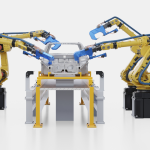UK manufacturing is driving industrial demand, accounting for 27% of space take-up in 2024 and showcasing significant growth in advanced sectors. As regional hubs thrive and new technologies reshape the landscape, supply chain leaders must align with emerging trends to seize opportunities in a competitive market.
The UK manufacturing sector accounted for 27% of industrial space take-up in 2024, according to Knight Frank’s Future Gazing report. Over the past decade, manufacturing output has grown by 9%, driving demand for high-quality facilities in regions with skilled labor and tax incentives, such as freeports and investment zones. Notably, manufacturers have occupied 28 million sq ft of space in the last three years, representing a quarter of the UK’s industrial and logistics demand.
Regions like the North West, West Midlands, and Yorkshire and Humber dominate in manufacturing floor space, benefiting from enterprise zones and investment initiatives. For instance, South Yorkshire’s £80 million investment zone focuses on advanced manufacturing, including sustainable aviation technologies. Looking ahead, the sector is projected to grow by 12% by 2033, with advanced manufacturing businesses requiring modern, high-specification facilities.
Sectoral Growth and Regional Dynamics
Food manufacturing, the largest sub-sector, accounts for 12% of UK manufacturing output and is forecasted to grow by 14% over the next decade, driving facility upgrades. Meanwhile, the automotive industry, bolstered by investments in electric vehicle (EV) and battery production, continues to expand, particularly in the North West and West Midlands. However, the sector faces risks from global trade policies and EV adoption trends, with 70% of UK-produced cars exported, over half to the EU.
Aerospace and defense spending has surged due to geopolitical tensions, with firms like BAE Systems and the Ministry of Defence securing significant manufacturing spaces in 2024. This growth is supported by a 14-year backlog in commercial aircraft production and regional defense spending, which is critical for local economies outside London and the South East.
A Blueprint for Future Opportunities
The evolving UK manufacturing landscape presents opportunities for real estate investors, particularly in high-growth sub-sectors like advanced manufacturing and food production. However, navigating market nuances is essential, as rising business rates, labor costs, and shifting trade policies pose challenges. Tax-incentivized locations, such as freeports and investment zones, are expected to attract occupiers seeking to offset these pressures.
Knight Frank’s experts highlight the sector’s transformation, driven by AI, automation, and reshoring efforts post-pandemic. While uncertainties remain, the long-term outlook for UK manufacturing as a key driver of industrial demand is promising, with sustained growth anticipated over the next decade. For supply chain leaders, this underscores the importance of aligning strategies with emerging regional and sectoral trends to capitalize on opportunities.







